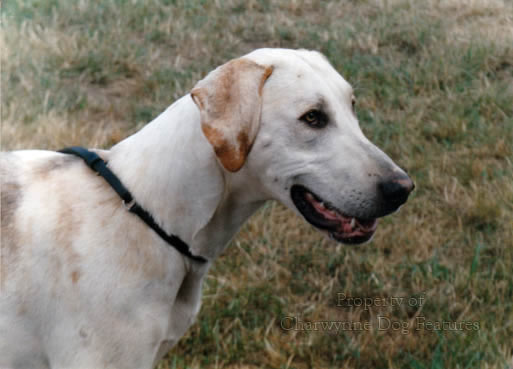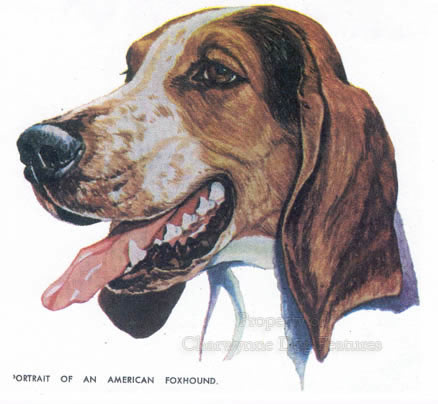643 Protecting the Constitution
PROTECTING THE CONSTITUTION
by David Hancock
.jpg) There are any number of canine terms or descriptions which over the years have either fallen into disuse or lost their meaning. Words like messet, riggot, sapling and lymer; expressions like dog-breaking, in and in breeding, saw-horse stance, sand toe and east-west action, and distinct forms of a breed like a fox collie, a Wold greyhound, an Anglesea setter and a chinchilla hound have all lapsed. There is one old- fashioned word however which could with justification be revived, the word 'constitution' .As a boy I can remember being asked by a kindly relative if my puppy had a 'good constitution.' It meant robustness, natural resilience, disease-resistance or, in old dictionaries, the natural condition of the body. Sadly, today, far too many dogs are not robust, have little natural resilience or disease-resistance and their bodies are simply not in a 'natural condition' .
There are any number of canine terms or descriptions which over the years have either fallen into disuse or lost their meaning. Words like messet, riggot, sapling and lymer; expressions like dog-breaking, in and in breeding, saw-horse stance, sand toe and east-west action, and distinct forms of a breed like a fox collie, a Wold greyhound, an Anglesea setter and a chinchilla hound have all lapsed. There is one old- fashioned word however which could with justification be revived, the word 'constitution' .As a boy I can remember being asked by a kindly relative if my puppy had a 'good constitution.' It meant robustness, natural resilience, disease-resistance or, in old dictionaries, the natural condition of the body. Sadly, today, far too many dogs are not robust, have little natural resilience or disease-resistance and their bodies are simply not in a 'natural condition' . .jpg)
A century ago, writers prized constitution in their dogs. The Foxhound magazine of 1909 referred to inbreeding as a threat to it: 'a great (perhaps the greatest) factor of success in the field, namely, constitution, is lost' .The writer had found from personal experience that 'loss of constitution entails many evil consequences', listing the the inability of hounds to hunt when required, increase in mortality from disease, irregularity of conformation and lack of physical development. A century later, are we breeding dogs with an enhanced constitution, what with scientifically designed food, immense advances in veterinary science, thousands of books on rearing and caring and a century and a half of dog-shows exhibiting the 'best of the very best'? Dissenters might argue that modern dog food is weakening our dogs, over-immunisation is harming our dogs and modern lifestyles punishing our dogs! An elderly vet told me recently that it was his view that today's dogs were sicklier than at any time previously. 
A couple of decades ago when the management of a rare breeds farm was part of my responsibilities, we crossed a wild boar with a Tamworth sow to create what we called an 'iron-age pig' . The resultant piglets were astonishingly virile, amazingly robust, remarkably precocious and just glowing with health and vitality, noticeably more so than the pure Tamworths and Gloucester Old Spots. When our pure Bagot goats became unacceptably prone to bloat, we successfully outcrossed to a Swiss breed, reducing the incidence of bloat to practically zero and producing far more robust more active kids. After three generations of breeding back to pure Bagots, every trace of outside blood had disappeared and our stock once again won at the livestock shows. When I mention this to pedigree dog breeders they pretend not to hear!
No Foxho und breeder would endlessly breed just from his own stock. In seeking, not just a stronger constitution, but enhanced performance, outcrosses would be introduced: to French hounds, Fell hounds, Harriers, American Foxhounds, Welsh Hounds, even Bloodhounds, as well as drafts from other unrelated packs. Breeding for function imposes such a method; but in the show dog world such thinking would instantly reveal the 'only over my dead body' school of opposition. When a BBC programme on dogs mentions the dreaded word 'eugenics' the pedigree dog breeders reach for their shotguns. Perhaps they should reach for their books on genetics. In the wider livestock world, purity of blood is only valued when it's working. Our famous breeds of dog came to us from open-minded pioneer breeders using the best blood they could and to the best purpose. To permit your breed to become paralysed by its genes is not my idea of animal welfare, not sound breeding practice and certainly not the most convincing way to demonstrate affection for a breed.
und breeder would endlessly breed just from his own stock. In seeking, not just a stronger constitution, but enhanced performance, outcrosses would be introduced: to French hounds, Fell hounds, Harriers, American Foxhounds, Welsh Hounds, even Bloodhounds, as well as drafts from other unrelated packs. Breeding for function imposes such a method; but in the show dog world such thinking would instantly reveal the 'only over my dead body' school of opposition. When a BBC programme on dogs mentions the dreaded word 'eugenics' the pedigree dog breeders reach for their shotguns. Perhaps they should reach for their books on genetics. In the wider livestock world, purity of blood is only valued when it's working. Our famous breeds of dog came to us from open-minded pioneer breeders using the best blood they could and to the best purpose. To permit your breed to become paralysed by its genes is not my idea of animal welfare, not sound breeding practice and certainly not the most convincing way to demonstrate affection for a breed.
Writers in the Foxhound magazine of 1909 had no doubt about the dangers of only breeding a 'fashionable' hound: 'We maintain the real cause is the result of loss of constitution from inbreeding, in order to obtain the requirements of the one exclusive Show standard type and the artificial characteristics necessary to the same object. ' and ...the answer is that the constitution of the fashionable hound, deteriorated by the process of inbreeding...is consequently unable to take his place in the field so frequently... ' Another contributor wrote that 'In course of time the crosses of one line of blood become so numerous that, whilst type is produced (and even that will in time fail to ensue...). ..constitution is lost. ' These writers bred superb hounds, for function, and their words should not be dismissed lightly.
I applaud the Kennel Club's campaign to breed dogs which are 'fit for function'; if they see it through then every breed, not just the sporting ones, should benefit. In quite a significant way it could be the leading edge in a new canine fundamentalism. For dog breeders this isn't merely a change of approach, it is a moral challenge. The Czech-born writer- philosopher Milan Kundera has a message for us all when he writes: 'Mankind's real moral test, a test so radical and so deep that it escapes our gaze, is probably the one of its relations with those that are the most at its mercy: the animals.’